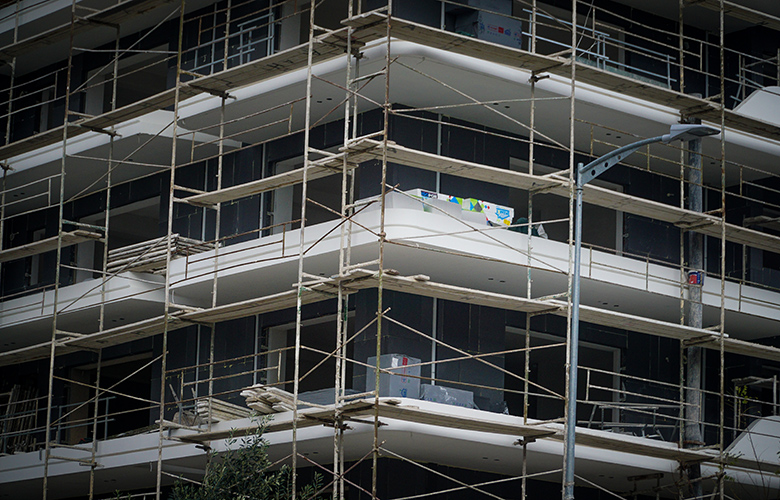All changes to 12 questions and answers
The amendment to Tuesday was tabled in Parliament late Tuesday night Ministry of Environment and Energy to adapt the incentives of the new building regulation to the suggestions of the Council of State.
The amendment has been incorporated into the law of the Ministry of Justice voted on Wednesday. It is recalled that the law of 2012 gave motivation for height construction, more floors, that is.
Whichever construction They have been completed have no issue, as Ertnews reporter Katerina Christofilidou said. From there on There are two different categories: those who started building work until December 11th and those who did not start.
Those who did not start building work should review their licenses. That is, all the incentives and increases given with the initial license should be deducted. This will be done immediately and will be refunded all the taxes that they have paid in order to comply with existing legislation.
Important note is that the Council of State It does not say that it is unconstitutional in general to give incentives to increase the building factor, but it says that this law cannot operate horizontally and that special planning plans should have been preceded. That is, science to determine what is the carrying capacity of each region and what motives can be given. Therefore, in the future, when these special urban planning plans are completed, some areas actually get some incentives to increase the building factor.
In those cases that have begun work, but whether they are in pending litigation, that is, there are appeals to the courts, or there are cases of residential investments funded by the Recovery Fund, the environmental balance is established. That is, in order not to lose the residential environment, there will be an environmental balance that should be paid by the contractors. This will go to the Deposits and Loans Fund, to the Green Fund and it will be decided by the relevant municipalities to create public green spaces, etc.
Here are explanatory questions and answers about the legislation of the Ministry of Environment and Energy:
1. What is the main objective of the new RIS regulation?
Following the specific decisions of the plenary session of the Council of State (146-149/2025), which judged the horizontal application of the incentives and increases of the knockout unconstitutional, a regime of uncertainty has been created, both to the owners of real estate and investors, as well as in administration, with immediate, adverse effects.
With respect to the relevant decisions of the plenary session of the CoE and in their spirit, the provisions of the NOK that were deemed unconstitutional are abolished, while incorporating the motives whose horizontal application were considered unconstitutional into local urban planning. This prevents stagnation, frustration and delays of new constructions that the country and citizens need. The environment is protected and the legal security is restored.
2. What is the regulation?
The arrangement concerns all building permits issued under the NOK and use the specific incentives and surcharges that were deemed unconstitutional. It also concerns buyers, investors, manufacturers and building services (YOM), which have the power to issue and revise building permits.
3. What is true for new licenses?
From now on, the knocking of the knockouts are not foreseen, as the Council of State has ruled that they could be integrated and documented in the urban planning of each area.
4. What does it mean that the incentives will be able to be included in the integrated urban planning?
This period is implemented by the Ministry of Environment and Energy, the flagship program of urban reforms “Konstantinos Doxiadis”, with local and special planning plans (ICT – EPS) for 80% of the territory. Through the ICTs, scholars can determine, after scientific documentation, special motivation zones, where the motives of the NOK will be provided -which have been given horizontally -taking into account the location, the degree of residential development of each settlement, its particularities, its characteristics, its characteristics, its characteristics, its characteristics, its characteristics, its characteristics and its residential density.
5. Who reserves the right to build with the motivation and increases of the knockout?
Those who have a building permit with NOK motives and surcharges and have begun construction work (eg excavations) until December 11, 2024, may proceed with the implementation of their building permit, without revision or financial burden, while they are explicitly granted the possibility of reviewing their license. By presidential decree, following the relevant guidelines of the CoE, the terms and conditions with which it proves that work has been launched by December 11, 2024, will be described in detail.
6. What about those who did not start building work (eg excavations) until December 11, 2024? Do they lose the right to build?
Under no circumstances is the right to build, but they must review their building permit in order to eliminate motives and surcharges. Thus, they do not lose the right to construct, except in so far as it relates to these incentives and surcharges.
7. Is there any concern for those who are required to review their building permit? Should they pay again for the review?
There is relevant care. No, no other taxes, fees, contributions or reservations are paid for these revisions. These revisions are carried out by the competent construction services inexpensive, without delay and priority.
8. What is foreseen for those who have licenses that have not started construction until December 11, 2024, but are integrated or will be integrated into financial tools (NSRF, TAA)?
In these cases, in order to maintain the country’s credibility towards institutional partners, investors and beneficiaries of European financing programs and to ensure the implementation of the projects, an environmental equivalent is provided, which offset the use of NOK’s incentives and increases. The environmental equivalent has a dual substance: a) the payment of a fee and b) targeted interventions to upgrade the municipal unit or municipality, where a building with motivation and surcharges is constructed. These measures are specialized in a specific environmental equivalent of cities (ESPIAP). In conclusion, in order for the incentives and increases of the NOK to be used, the environmental equivalent should be paid and the ESPIE have been approved. Maintaining the validity of these licenses is inextricably linked to the enhancement of the Greek State’s financial credit, the fulfillment of our country’s obligations arising from contractual commitments to the European Union and the maintenance of international investment confidence.
9. What is the Special Environmental Equivalent City Equivalence Plan (ESPIAP)?
ESPIAP is a special study introduced by the Ministry of Environment and Energy. ESPIAP specifies the measures of the environmental equivalent, that is, the targeted interventions that will be made at the municipal or municipal level, where the incentives and surcharges of the NOK have been given. The preparation of ESPIAP provides legal shielding and the ability to use the incentives, without changes in the building permit, for the cases in which it is provided. It is a key tool for enhancing market confidence and immediate resumption of building activity.
It may include, inter alia, description of the area and existing licenses, analysis of legal issues and canceled licenses, environmental evaluation and impact, proposals for management and adjustment of projects, a timetable for implementation and economic analysis, monitoring – evaluation – recommendations – documentation.
The Presidential Decree will allow the environmental equivalent measures to be specified, to determine the approval of the ESPIAP approval, as well as the height and process of the end.
10. What can be the environmental equivalents suggested by an ESPIA?
- Creating green spaces and communal spaces
- Restorations of areas with intense construction
- Urban Infrastructure or Upgrades (Pavements, Lighting, Urban Furniture Material, etc.)
- Priority demolition of arbitrary or even dangerous (arranged) buildings
- The funding of the acquisition of preserved buildings and monuments by the municipality concerned, as well as the restoration of public preserved buildings and monuments
- Environmental actions such as cleaning and delimiting streams and arrangement projects.
11. What is foreseen for those who had launched construction work by December 11, 2024, based on the legislative framework in force then, but are facing cancellation applications or licenses have already been canceled?
In this case too, the environmental equivalent is applied and licenses are in place. This is foreseen in order to prevent the phenomenon of abandoned unfinished buildings that degrade the environment and has a serious impact on public health and safety.
In particular, if the bearing body of the building has been completed, the construction process continues immediately, with the incentives and increases, if the environmental equivalent is paid and the ESPIAP preparation is launched.
If the Bear Organization has not been completed, the Central Council of Architecture and the Central Council of Urban Planning and Doubts of the Ministry of Environment and Energy are involved in order to examine with technical, social, economic and legal criteria the need for or not to continue the implementation of the building permit and the motives. After securing the aforementioned approvals, construction can continue with the motives and NOK increases, provided that the environmental equivalent is paid and the ESPIAP preparation began.
12. Are there any specific categories of licenses excluded from environmental equivalent?
Yes, licenses that are included in specific spatial development plans are excluded from the environmental equivalent, as special scientific documentation has been preceded. The same is true of preserved buildings and monuments, with the aim of protecting and promoting them and strengthening the cultural heritage, which contributes to the upgrading of the cultural environment.




